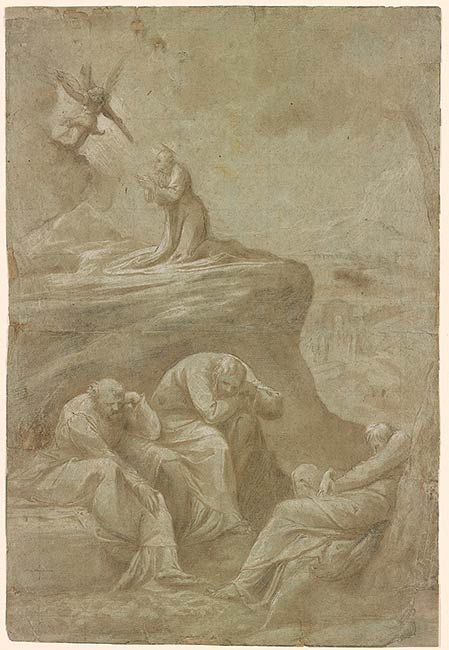
Recognized as the work of Polidoro da Caravaggio by Philip Pouncey in 1958, this drawing was subsequently linked by Rolf Kultzen to a fresco of the same subject in the Cappella della Passione in Santa Maria della Pietà in Camposanto Teutonico, Rome, painted by Polidoro around 1520–22.1 The painting, however, differs quite markedly from the drawing, which, as recent scholars seem to agree, was instead executed after Polidoro’s permanent departure from Rome in 1527. It is not yet clear, however, if the sheet belongs to the artist’s second Neapolitan sojourn of 1527–28 or if it was produced after 1528, when the painter moved to Sicily, where he remained until his death in around 1543. Affinities with Polidoro’s early Sicilian works, such as the Way to Calvary (ca. 1530), today in the Museo Nazionale di Capodimonte, Naples, but formerly in the Church of the Annunziata in Messina, may be easily detected in the Morgan drawing. The intensely dramatic tone of the scene, the theatrically expressive religiosity, and the oblong shapes of the figures are, in fact, reminiscent of Polidoro’s works realized during his early period in Messina.
Documents attest that at least two paintings attributed to Polidoro and representing the Agony in the Garden were housed in the famous Sicilian collections of il Commendator don Andrea di Giovanni and of the Ruffo family. Alessandro Marabottini suggested that the Morgan drawing may have served as a possible modello for one of the two pictures, both of which he thought were lost.2 An Agony in the Garden has, however, recently emerged on the art market, and one could be tempted to recognize it as one of the pictures mentioned in the early inventories, although it is impossible to be sure.3
An additional copy of the composition, now in the Louvre, is also known.4 Executed on a fine blue paper, the drawing shows details missing in the Morgan study and is more likely to have been derived from the painting than directly from the preparatory sketch. The copies of the composition nonetheless attest to an appetite in southern Italy for Polidoro’s devotional inventions, through which the artist contributed to the dissemination of the style of his Roman teacher, Raphael.
—MSB
Footnotes:
- Kultzen 1961, no. 31.
- Marabottini 1969, 1: no. 75.
- Blindarte, Naples, 29 November 2015, lot 150.
- Musée du Louvre, Paris, inv. 10131.
Watermark: none.
Inscribed on verso, at upper edge, in pen and brown ink, "Poccetti(?)"; in center, "HIS", and "Tari 4(?) [crossed out]".
Piancastelli, Giovanni, 1845-1926, former owner.
Brandegee, Edward, former owner.
Brandegee, Mary, former owner.
Scholz, János, former owner.
Rhoda Eitel-Porter and and John Marciari, Italian Renaissance Drawings at the Morgan Library & Museum, New York, 2019, no. 43.
Selected references: Kultzen 1961, 25n31, and pl. 15a; Marabottini 1969, 1:317, no. 75; 2: no. 4; Scholz 1976, 14, no. 37; Ravelli 1978, 107-8, no. 29; Fellows Report 19 1981, 180-81; Notre Dame 1983, 71, no. 35; Leone de Castris 2001, 482-83, no. 179.
Nineteenth report to the Fellows of the Pierpont Morgan Library, 1978-1980 / edited by Charles Ryskamp. New York : The Library, 1981, p. 180-181.
Scholz, Washington, D.C.-New York, 1973-1974, no. 3, repr. (includes previous bibliography and exhibition).
Scholz, Janos. Italian Master Drawings, 1350-1800, from the János Scholz Collection. New York : Dover, 1976, no. 37, repr.
